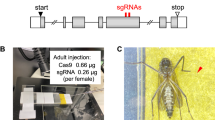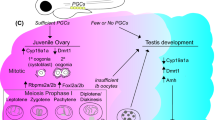Abstract
Transgenic marine medaka (Oryzias dancena) germlines were generated by the microinjection of the red fluorescent protein (RFP) reporter gene (rfp) driven by the endogenous choriogenin H gene (chgH) promoter. The selected transgenic lines contained multiple copies of the transgene (3–42 copies per cell) in their genomes. Although all the founders were mosaic, the transgene was stably transmitted from the F1 generation to all subsequent generations following a Mendelian pattern. Different transgenic lines showed different responsiveness to estradiol-17β (E2) exposure at the mRNA and protein levels, and the expression efficiency was dependent upon the transgene copy number. The induction of RFP was significantly affected by the developmental stage of transgenic larvae: later-stage larvae (older than 7 days post-hatching) showed higher sensitivity to E2 exposure than earlier-stage larvae. The response of transgenic expression to E2 was fairly dependent upon the E2 dose (200–3,200 ng/L) and exposure period (1–7 days), according to both a microscopic examination of RFP intensity and a qRT–PCR assay. The transgenic marine medaka showed similar transgenic responses to E2 under freshwater, brackish, and seawater conditions. In addition to E2, the transgenic RFP signal was also successfully induced during 1-week exposure to various other natural (1 μg/L estrone and 10 μg/L estriol) and synthetic (xeno)estrogens (0.1 μg/L 17α-ethynylestradiol, 1 μg/L diethylstilbestrol, and 10 mg/L bisphenol A). The efficiency of transgene expression varied greatly among the chemicals tested. The results of this study suggest that the chgH–rfp transgenic marine medaka species will be useful in the in vivo detection of waterborne estrogens under a wide range of salinity conditions.






Similar content being viewed by others
References
Aoki JY, Nagae M, Takao Y, Hara A, Lee YD, Yeo IK, Lim BS, Park CB, Soyano K (2010) Survey of contamination of estrogenic chemicals in Japanese and Korean coastal waters using the wild grey mullet (Mugil cephalus). Sci Total Environ 408:660–665
Bogers R, Mutsaerds E, Druke J, De Roode DF, Murk AJ, Van Der Burg B, Legler J (2006) Estrogenic endpoints in fish early life-stage tests: luciferase and vitellogenin induction in estrogen-responsive transgenic zebrafish. Environ Toxicol Chem 25:241–247
Carvan MJ III, Dalton TP, Stuart GW, Nebert DW (2000) Transgenic zebrafish as sentinels for aquatic pollution. Ann NY Acad Sci 919:33–147
Chen X, Li VWT, Yu RMK, Cheng SH (2008) Choriogenin mRNA as a sensitive molecular biomarker for estrogenic chemicals in developing brackish medaka (Oryzias melastigma). Ecotoxicol Environ Saf 71:200–208
Chen H, Hu J, Yang J, Wang Y, Xu H, Jiang Q, Gong Y, Gu Y, Song H (2010) Generation of a fluorescent transgenic zebrafish for detection of environmental estrogens. Aquat Toxicol 96:53–61
Chen X, Li L, Cheng J, Chan LL, Wang DZ, Wang KJ, Baker ME, Hardiman G, Schlenk D, Cheng SH (2011) Molecular staging of marine medaka: a model organism for marine ecotoxicity study. Mar Pollut Bull 63:309–317
Cho YS, Lee SY, Kim DS, Nam YK (2010a) Tolerance capacity to salinity changes in adult and larva of Oryzias dancena, a euryhaline medaka. Korean J Ichthyol 22:9–16
Cho YS, Lee SY, Kim DS, Nam YK (2010b) Spawning performance, embryonic development and early viability under different salinity conditions in a euryhaline medaka species, Oryzias dancena. Korean J Ichthyol 22:25–33
Cho YS, Lee SY, Kim YK, Kim DS, Nam YK (2011) Functional ability of cytoskeletal β-actin regulator to drive constitutive and ubiquitous expression of a fluorescent reporter throughout the life cycle of transgenic marine medaka Oryzias dancena. Transgenic Res 20:1333–1355
Dai J, Cui X, Zhu Z, Hu W (2010) Non-homologous end joining plays a key role in transgene concatemer formation in transgenic zebrafish embryos. Int J Biol Sci 6:756–768
Dorer DR, Henikoff S (1997) Transgene repeat arrays interact with distant heterochromatin and cause silencing in cis and trans. Genetics 147:1181–1190
Fujita T, Fukada H, Shimizu M, Hiramatsu N, Hara A (2008) Molecular cloning and characterization of three distinct choriogenins in masu salmon, Oncorhynchus masou. Mol Reprod Dev 75:1217–1228
Geurts AM, Collier LS, Geurts JL, Oseth LL, Bell ML, Mu D, Lucito R, Godbout SA, Green LE, Lowe SW, Hirsch BA, Leinwand LA, Largaespada DA (2006) Gene mutations and genomic rearrangements in the mouse as a result of transposon mobilization from chromosomal concatemers. PLoS Genet 2:e156
Hackett PB, Alvarez MC (2000) The molecular genetics of transgenic fish. In: Fingerman M, Nagabhushanam R (eds) Recent advances in marine biotechnology, vol 4. Science Publishers, Enfield, pp 77–145
Inoue K, Takei Y (2002) Diverse adaptability in Oryzias species to high environmental salinity. Zool Sci 19:727–734
Kang CK, Tsai SC, Lee TH, Hwang PP (2008) Differential expression of branchial Na+/K+-ATPase of two medaka species, Oryzias latipes and Oryzias dancena, with different salinity tolerances acclimated to fresh water, brackish water and seawater. Comp Biochem Physiol Part A 151:566–575
Kim DS, Kim BS, Lee SJ, Park IS, Nam YK (2004) Comparative analysis of inherited patterns of the transgene in transgenic mud loach Misgurnus mizolepis lines carrying the CAT reporter gene. Fish Sci 70:201–210
Koh CH, Khim JS, Villeneuve DL, Kannan K, Johnson BG, Giesy JP (2005) Instrumental and bioanalytical measures of dioxin-like and estrogenic compounds and activities associated with sediment from the Korean coast. Ecotoxicol Environ Saf 61:366–379
Kubista M, Andrade JM, Bengtsson M, Forootan A, Jonák J, Lind K, Sindelka R, Sjöback R, Sjögreen B, Strömbom B, Ståhlberg A, Zoric N (2006) The real-time polymerase chain reaction. Mol Aspects Med 27:95–125
Kurauchi K, Nakaguchi Y, Tsutsumi M, Hori H, Kurihara R, Hashimoto S, Ohnuma R, Yamamoto Y, Matsuoka S, Kawai S, Hirata T, Kinoshita M (2005) In vivo visual reporter system for detection of estrogen-like substances by transgenic medaka. Environ Sci Technol 39:2762–2768
Kurauchi K, Hirata T, Kinoshita M (2008) Characteristics of ChgH–GFP transgenic medaka lines, an in vivo estrogenic compound detection system. Mar Pollut Bull 57:441–444
Lam SH, Hlaing MM, Zhang X, Yan C, Duan Z, Zhu L, Ung CY, Mathavan S, Ong CN, Gong Z (2011) Toxicogenomic and phenotypic analyses of bisphenol-A early-life exposure toxicity in zebrafish. PLoS ONE 6:e28273
Lange A, Katsu Y, Miyagawa S, Ogino Y, Urushitani H, Kobayashi T, Hirai T, Shears JA, Nagae M, Yamamoto J, Ohnishi Y, Oka T, Tatarazako N, Ohta Y, Tyler CR, Iguchi T (2012) Comparative responsiveness to natural and synthetic estrogens of fish species commonly used in the laboratory and field monitoring. Aquat Toxicol 109:250–258
Lee SY, Kim DS, Nam YK (2012) Gene structure and estrogen-responsive mRNA expression of a novel choriogenin H isoform from a marine medaka (Oryzias dancena). Fish Aquat Sci 15 (in press)
Legler J, Broekhof JLM, Brouwer A, Lanser PH, Murk AJ, Van der Saag PT, Vethaak AD, Wester P, Zivkovic D, Van der Burg B (2000) A novel in vivo bioassay for (xeno-)estrogens using transgenic zebrafish. Environ Sci Technol 34:4439–4444
Ma L (2009) Endocrine disruptors in female reproductive tract development and carcinogenesis. Trends Endocrinol Metab 20:357–363
Matzke MA, Mette MF, Matzke AJ (2000) Transgene silencing by the host genome defense: implications for the evolution of epigenetic control mechanisms in plants and vertebrates. Plant Mol Biol 43:401–415
Nam YK, Noh CH, Kim DS (1999) Transmission and expression of an integrated reporter construct in three generations of transgenic mud loach (Misgurnus mizolepis). Aquaculture 172:229–245
Nam YK, Noh JK, Cho YS, Cho HJ, Cho KN, Kim CG, Kim DS (2001) Dramatically accelerated growth and extraordinary gigantism of transgenic mud loach Misgurnus mizolepis. Transgenic Res 10:353–362
Nam YK, Park JE, Kim KK, Kim DS (2003) A rapid and simple PCR-based method for analysis of transgenic fish using a restricted amount of fin tissue. Transgenic Res 12:523–525
Nam YK, Maclean N, Fu C, Pandian TJ, Eguia MRR (2007) Development of transgenic fish: scientific background. In: Kapuscinski AR, Hayes KR, Li S, Dana G (eds) Environmental risk assessment for genetically modified organisms, vol 3. CABI Press, Cambridge, pp 61–94
Nam YK, Maclean N, Hwang G, Kim DS (2008) Autotransgenic and allotransgenic manipulation of growth traits in fish for aquaculture: a review. J Fish Biol 72:1–26
Paul-Prasanth B, Shibata Y, Horiguchi R, Nagahama Y (2011) Exposure to diethylstilbestrol during embryonic and larval stages of medaka fish (Oryzias latipes) leads to sex reversal in genetic males and reduced gonad weight in genetic females. Endocrinology 152:707–717
Rahman MA, Hwang GL, Razak SA, Sohm F, Maclean N (2000) Copy number related transgene expression and mosaic somatic expression in hemizygous and homozygous transgenic tilapia (Oreochromis niloticus). Transgenic Res 9:417–427
Ramakrishnan S, Wayne NL (2008) Impact of bisphenol-A on early embryonic development and reproductive maturation. Reprod Toxicol 25:177–183
Salam MA, Sawada T, Ohya T, Ninomiya K, Hayashi S (2008) Detection of environmental estrogenicity using transgenic medaka hatchlings (Oryzias latipes) expressing the GFP-tagged choriogenin L gene. J Environ Sci Health, Part A 43:272–277
Scholz S, Kurauchi K, Kinoshita M, Oshima Y, Ozato K, Schirmer K, Wakamatsu Y (2005) Analysis of estrogenic effects by quantification of green fluorescent protein in juvenile fish of a transgenic medaka. Environ Toxicol Chem 24:2553–2561
Song HY, Nam YK, Bang IC, Kim DS (2009) Embryogenesis and early ontogenesis of a marine medaka, Oryzias dancena. Korean J Ichthyol 21:227–238
Stegeman JJ, Goldstone JV, Hahn ME (2010) Perspectives on zebrafish as a model in environmental toxicology. Fish Physiol 29:367–439
Thorpe KL, Cummings RI, Hutchinson TH, Scholze M, Brighty G, Sumpter JP, Tyler CR (2003) Relative potencies and combination effects of steroidal estrogens in fish. Environ Sci Technol 37:1142–1149
Tokumoto T, Tokumoto M, Horiguchi R, Ishikawa K, Nagahama Y (2004) Diethylstilbestrol induces fish oocyte maturation. PNAS 101:3686–3690
Ueno T, Yasumasu S, Hayashi S, Iuchi I (2004) Identification of choriogenin cis-regulatory elements and production of estrogen-inducible, liver-specific transgenic Medaka. Mech Dev 121:803–815
Uh M, Khattra J, Devlin RH (2006) Transgene constructs in coho salmon (Oncorhynchus kisutch) are repeated in a head-to-tail fashion and can be integrated adjacent to horizontally-transmitted parasite DNA. Transgenic Res 15:711–727
Uzbekova S, Amoros C, Cauty C, Mambrini M, Perrot E, Hew CL, Chourrout D, Prunet P (2003) Analysis of cell-specificity and variegation of transgene expression driven by salmon prolactin promoter in stable lines of transgenic rainbow trout. Transgenic Res 12:213–227
Villeneuve DL, Garcia-Reyero N, Escalon BL, Jensen KM, Cavallin JE, Makynen EA, Durhan EJ, Kahl MD, Thomas LM, Perkins EJ, Ankley GT (2012) Ecotoxicogenomics to support ecological risk assessment: a case study with bisphenol A in fish. Environ Sci Technol 46:51–59
Yu RMK, Wong MML, Kong RYC, Wu RSS, Cheng SH (2006) Induction of hepatic choriogenin mRNA expression in male marine medaka: a highly sensitive biomarker for environmental estrogens. Aquat Toxicol 77:348–358
Zeng Z, Shan T, Tong Y, Lam SH, Gong Z (2005) Development of estrogen-responsive transgenic medaka for environmental monitoring of endocrine disrupters. Environ Sci Technol 39:9001–9008
Acknowledgments
This study was supported by a research grant from the Ministry of Land, Transport and Maritime Affairs, Korea (project #20088033-1).
Author information
Authors and Affiliations
Corresponding author
Rights and permissions
About this article
Cite this article
Cho, Y.S., Kim, D.S. & Nam, Y.K. Characterization of estrogen-responsive transgenic marine medaka Oryzias dancena germlines harboring red fluorescent protein gene under the control by endogenous choriogenin H promoter. Transgenic Res 22, 501–517 (2013). https://doi.org/10.1007/s11248-012-9650-y
Received:
Accepted:
Published:
Issue Date:
DOI: https://doi.org/10.1007/s11248-012-9650-y




